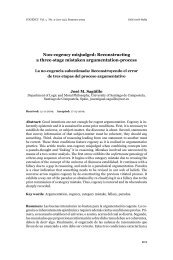Cogency v2 n2
Cogency v2 n2
Cogency v2 n2
Create successful ePaper yourself
Turn your PDF publications into a flip-book with our unique Google optimized e-Paper software.
Wittgenstein and the Logic of Deep Disagreement / D. M. GODDEN & W. H. BRENNER<br />
3. Wittgenstenian Elements of Fogelin’s Picture:<br />
Preliminary Observations<br />
To what extent is Fogelin’s picture genuinely Wittgenstenian? What are its<br />
Wittgenstenian elements?<br />
First, Wittgenstein (PI p. 225) accepted that there is a kind of disagreement<br />
(e.g., over the correct result of a calculation) which Fogelin would later<br />
call “highly normal.” These disagreements, Wittgenstein claimed, can be<br />
decided ‘with certainty;’ yet he also claimed that disputes of this kind are<br />
essentially “rare and of short duration” and thus not normally characteristic<br />
of ordinary argumentative situations. Highly normal disagreements are<br />
a-typical and, for the most part, straightforwardly uninteresting both philosophically<br />
and argumentatively.<br />
Fogelin further claimed that deep disagreements arise from, and amount<br />
to, differences in forms of life. If this is so, then it would seem that they are<br />
genuinely basic, or fundamental differences, for Wittgenstein (PI, p. 226)<br />
held that “What has to be accepted, the given, is – so one could say – forms<br />
of life.” What is basic, for Wittgenstein – what lies at the end of all paths of<br />
justification and reason-giving are ways of doing – sets of practices learned<br />
through training (OC § 110; cf. §§ 204, 559; PI § 217).<br />
A second Wittgensteinian element of Fogelin’s picture is the idea that<br />
argumentative words have their meaning only within some roughly fixed<br />
and established framework of linguistic and other normative practices. Indeed,<br />
the very evidentiary and semantic relationships drawn upon in argument,<br />
and used to identify and evaluate reasons, are inter-framework relationships<br />
(OC §§ 105, 82; AWL, p. 26).<br />
These two ideas – that forms of life are basic and that reason-giving argument<br />
can only occur within a system – come together in Wittgenstein’s<br />
notion of a Weltbild (“world-picture”).<br />
Roughly, for Wittgenstein, in learning our mother tongue we become<br />
enculturated into a form of life which is comprised of a rich set of ways-ofdoing<br />
and an attendant Weltbild. This, in turn, amounts to learning a vast<br />
set of beliefs about the world (OC §§ 83, 141). The Weltbild and the way of<br />
life are connected through the very grammar of language (OC § 140). While<br />
providing a certain description of the world (if you will), the Weltbild we<br />
learn is not something which we rationally accept by a process of reasoning,<br />
45








